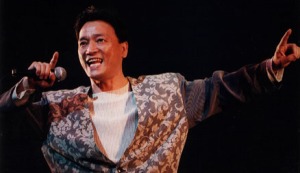The most compelling, expressive and soulful instrument of all is the human voice. Outside of most western music, some vocalists have an ability to capture a certain indefinable sense of yearning. Voices with a fiery beauty and explosive power; intimate, haunting, ageless, mysterious. Some of the best known are West Africa’s Salif Keita and Youssou N’dour, or from Pakistan the late Nusrat Fateh Ali Khan, but there are several other lesser known names from around the world. So, who could possibly be Japan’s representative in such illustrious company? Step forward Takio Ito.
As with other great singers, Ito is not only blessed with an inimitable voice, but has constantly striven to develop and expand his tradition, in Ito’s case min’yo or Japanese folk music. Takio Ito was born in Tomakomi, Hokkaido in 1950, the youngest of identical twins and the last of 13 children, or “the last drop of my parents” as he puts it.
His father was a poor fisherman in a seaside village which didn’t even have electricity until he was 12 years old. According to Ito, his expanded vision was conceived growing up and listening to his family’s singing. They would sing min’yo, but Ito never knew what it was called. “Sometimes I helped my father fish on his boat. As he rowed or drew the fishing net he’d say “oh-o-shi, koh-o-shi” or “yara-dockoy, dockoyosho”. I couldn’t figure out if it was a call or a song, but now I believe he was singing for himself, and it soaked into my body and heart. That’s why I don’t like to distinguish one music style from others; enka or rock or jazz.”
Min’yo (derived from the German word ‘Volklied’) is the standard term for folk songs, and are associated with particular communities or districts throughout Japan. Songs typically relate to work, weddings, drinking, or to pray for the spirit of a tree or animal. Those lyrics can be personal or local or sometimes near nonsense. However, the real meaning and spirit of min’yo, is believed to have somehow gotten lost during the Meiji period of modernization in Japan in the second half of the 19th century. The government strove hard to root out traditional culture, deemed not suitable for a western style nation. Many min’yo songs were re-written and only government approved min’yo came to be recorded or played on the radio. Pockets of true min’yo survived however in rural regions, including Ito’s hometown.
It was the devastation of min’yo that eventually led to the evolution of ‘Japanese pops’, and some believe the definition of min’yo to not be a folk music at all. “The image of min’yo is like a traditional music” says Ito, “but min’yo has always been for the common people. It was simply the popular music of the time.” The rather conservative Min’yo Association and other preservation societies have probably fostered the traditional image, and have strict credentials for issuing teaching licenses. At 18 years old Takio Ito was the youngest ever certified teacher. He went on to win the national Min’yo championship three years running, and his reputation was firmly established.
Ito was to find the confines of belonging to the Association stifling for his creativity and promptly quit in 1981, declaring his teachers could tell him nothing. He became independent, thereby foregoing the chance to perform publicly with ease or teach. “They” (the Association), he says, “called me crazy”. “Min’yo has always changed through the years, and has adapted and been influenced by each particular period of time. Because min’yo is thought of as traditional these days and taught as such, you can’t hear it in the cities or on the streets anymore. I wanted to let people know what min’yo is, so to do that I mixed min’yo with jazz or rock and played at usual live houses. In reality there are no rules to Min’yo, you sing how you feel. That can be happy or sad or I get some power from the audience and I just express my feelings. My father used to sing Soran Bushi (a Hokkaido fishing song) differently everytime. That original working style of min’yo was just voice and clapping.”
Ito’s own updated, powerful rocking versions of ‘Soran Bushi’, have become one of his trademark songs, and have even been adopted by schools throughout Japan, some of which have formed troupes of dancers to accompany the song. “One of the points of min’yo is the call and response vocals. That can help make you feel at one with the people you’re with.” observes Ito. As an independent voice, Ito has been expanding the realms of min’yo by incorporating jazz and rock plus other Asian and Japanese traditional elements, while bass, guitar, violin, piano and drums are combined with shamisen, shakuhachi and taiko. In some ways, Takio Ito represents the true ‘soul’ of Japan, and shows how a tradition can keep it’s essence and evolve without selling out to western music.
Go to the Shopping Page for Takio Ito


